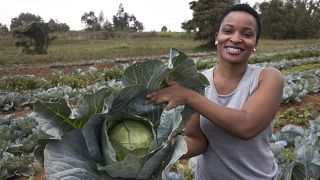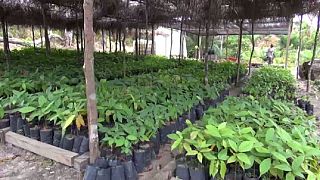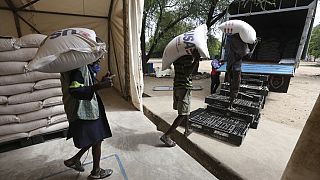Zimbabwe
Jestina Nyamukunguvengu picks up a hoe and slices through the soil of her fields that are lush green with a pearl millet crop in Zimbabwe's arid Rushinga district.
While others in her Zimbabwean village agonise over a maize crop seemingly headed for failure, Nyamukunguvengu is confident of a good harvest.
Millets, including sorghum, now take up over two hectares of her land — a patch where maize was once the crop of choice.
"We grew up farming millet, but we stopped it years back. The maize we adopted as our staple food, it needs a lot of water, so, we have returned to millets. They are laborious to grow, the work is hard, but it is worth it. It's better to endure the pain because many people are surviving," she says.
"I got a lot of money from millet farming, I even use the money to take my children to school, to buy food and even building my house. Recently I bought my roofing sheets for my house using money I made from small grains after the WFP bought my millet. I was so happy, and I can tell you I will never leave millet farming," says another local farmer, Maria Chagwena.
Indian project
These farmers are on the front lines of a project proposed by India that has led the U.N.'s Food and Agricultural Organisation to name 2023 as "The Year of Millets. "
It is an effort to revive a hardy and healthy crop that has been cultivated for millennia — but was largely elbowed aside by European colonists who favoured corn, wheat and other grains.
The designation is timely.
Last year, drought swept across much of eastern Africa; war between Russia and Ukraine upended supplies and raised the prices of foodstuffs and fertilizer from Europe's breadbasket.
Worries surged about environmental fallout of cross-globe shipments of farm products.
Many chefs and consumers are looking to diversify diets at a time of excessively standardised fare.
All that has given a new impetus to locally-grown and alternative grains and other staples like millets.
Reviving ancient crops
Pierre Thiam, is an executive chef and co-founder of New York-based fine-casual food chain Teranga, which features West African cuisine.
The U.S.-based chef, recalled eating fonio as a kid in Senegal's southern Casamance region, but worried that it wasn't often available in his hometown — the capital — let alone New York.
A fan of the grain, he claims it is a healthy option — they can be rich in proteins, potassium, and vitamin B — and most varieties are gluten-free.
"The fact that Fonio/Millet is great for the environment. It's a grain that grows in poor soil, that restores the soil, that adds...that's nutritious - nutrition powerhouse, that's gluten free. So, you have all those things. For me, it was the perfect grain that could really - not only have an impact on the environment, but also bring economic opportunity for those people, in Kedougou, like I said, that was the poorest region. And this could be a way for them to get access to income," he says.
Millets are more tolerant of poor soils, drought and harsh growing conditions, and can easily adapt to different environments without high levels of fertilizer and pesticide.
They don't need nearly as much water as other grains, making them ideal for places like Africa's arid Sahel region.
They also have environmental benefits. The deep roots of varieties like fonio can help mitigate desertification, the process that transforms fertile soil into desert, often because of drought or deforestation.
And they're versatile: useful in everything from bread, cereal and salads to pudding and even beer.
Thiam whisks up a salmon salad served with millet and praises the grain's versatility.
"Fonio/Millet is very versatile. You can make, you know, traditionally people make porridges with fonio/millet. When you cook it the simple way it looks like a couscous, it is like tiny and fluffy and that's just one way to have it. And that is because of its neutral flavour. It has a neutral flavour. So, you can really add a fonio to many different types of cuisines. It can be served with any sauce you can imagine."
Millets come in multiple varieties, such as finger millet, fonio, sorghum, and teff, which is used in the spongy injera bread familiar to fans of Ethiopian cuisine.
Over centuries, millets have been cultivated around the world — in places like Japan, Europe, the Americas and Australia — but their epicentres have traditionally been India, China, and sub-Saharan Africa.
Millets account for less than 3% of the global grain trade, according to FAO (Food and Agriculture Organisation).
Growing popularity
But cultivation is growing in some arid zones.
In Rushinga district, land under millets almost tripled over the past decade.
The U.N.'s World Food Programme deployed dozens of threshing machines and gave seed packs and training to 63,000 small-scale farmers in drought-prone areas in the previous season.
Low rainfall and high temperatures in recent years in part due to climate change, coupled with poor soils, have slowed interest in water-guzzling maize.
"You'll find the ones who grew maize are the ones who are seeking food assistance, those who have grown sorghum or pearl millet are still eating their small grains," says Melody Tsoriyo, the district's agronomist, alluding to small grains like millets, whose seeds can be as fine as sand.
Government teams in Zimbabwe have fanned out to remote rural regions, inspecting crops and providing expert assistance such as through WhatsApp groups to spread technical knowledge to farmers.
WFP spokesman Tatenda Macheka says millets "are helping us reduce food insecurity" in Zimbabwe.
Here about a quarter of people in the country of 15 million — long a breadbasket of southern Africa — are now food insecure, meaning that they're not sure where their next meal will come from.
At this restaurant in the capital Harare, diner Bright Musiwa is proud that the food of his childhood is becoming popular in urban areas.
"We used to enjoy and eat this kind of food when we were still in the rural areas, and I am happy that now people in urban areas have also started cooking the traditional food the Zimbabwean food. Now instead of us going into the rural areas to eat this kind of food we are having it in town."
In urban areas of Zimbabwe and well beyond, restaurants and hotels are riding the newfound impression that a millet meal offers an element of class, and have made it pricier fare on their menus.












02:30
Morocco’s oases struggle to survive amid growing desertification
Go to video
Zimbabwe court rejects opposition bid to block Gukurahundi massacre hearings
02:19
South African actor Embeth Davidtz makes directorial debut with Rhodesia-set drama
Go to video
South Sudan: UN warns of imminent famine
Go to video
To avoid conflicts with locals, Zimbabwe tracks elephants with GPS
Go to video
Putin hosts talks with African leaders on security